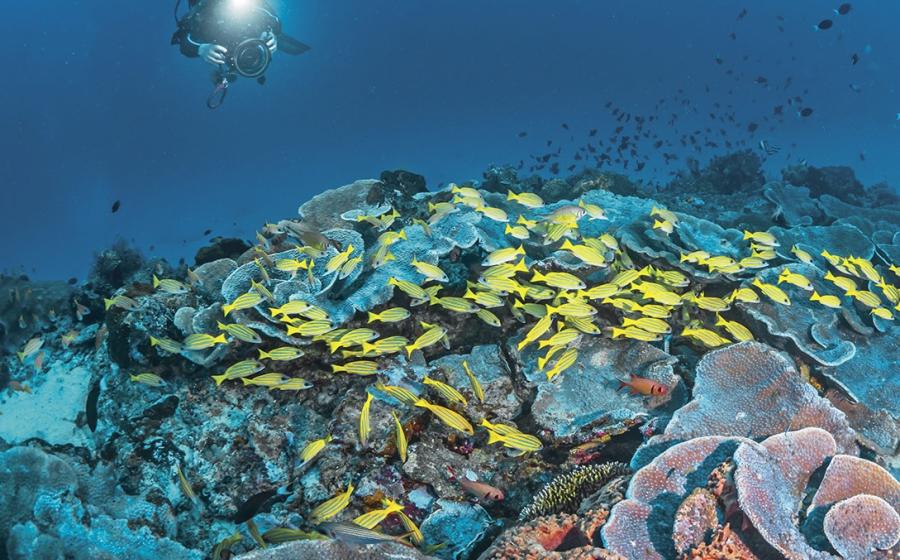Check out the Top 10 Dive Sites in Bermuda

Top Dive Sites in Bermuda
Top Dive Sites in Bermuda
Experience Confederate wrecks like the Mary Celestia and Montana, swim through dozens of dramatic archways and tunnels at sites like the haunting Cathedral, and much more with our interactive map of Bermuda's best dive sites.
In no particular order here are our top ten sites:
Mary Celestia
Mary Celestia was a side-paddlewheel steamer chartered by the Confederate Army during the American Civil War. It was used as a blockade-runner smuggling guns, ammunition and supplies to the troops. It's Bermuda’s most-talked-about wreck site owing to the fact that in June 2011 five intact bottles of 148-year-old wine were found in the bow compartment. Highlights include the bow, anchor, paddlewheels and boilers.
Hermes
A U.S. Coast Guard buoy tender until the end of World War II, Hermes was relocated to the Philippines as a freighter carrying mixed cargo. On the way to the Cape Verde Islands, the ship experienced engine trouble off the coast of Bermuda and was abandoned. Hermes was acquired by the Bermuda Dive Association and thoroughly cleaned and made diver-friendly before being sunk as an artificial reef project. Divers can either skirt the outside of the wreck or explore the delights within.
Related Reading: Diving Grenada: A Sea of Ships
Constellation
Built in 1918, this four-mast, wood-hull American schooner was pressed into service and used as a cargo vessel during World War II. In July 1943, it was bound for Venezuela carrying a general cargo of building materials, medicine and 700 cases of Scotch whisky when it sank. Today, its hull lies broken on a coral and sand bottom in 9 meters of water, exposing petrified sacks of cement, building supplies and glassware. The Constellation was the inspiration for Peter Benchley’s book The Deep.
Montana (Nola)
An elusive ship of multiple identities — often operating under the name of Nola, Gloria, Paramount and Montana — it was a Civil War blockade-runner that made trips between England, Bermuda and North Carolina. Bermuda’s shallow reefs accomplished what no Union gunboat could do when the Montana sank in December 1863. Lying in 9 meters of water, the partially intact wreck is marked by two steam boilers and two paddlewheel frames lying on their sides.
North Carolina
North Carolina was an English iron-hulled barque built in Liverpool. While in route from Bermuda to England with a cargo of cotton, bark and fuel, it hit a reef and sank on New Year’s Day, 1880. There was an attempt to refloat the ship, but it ended in disaster when an anchor broke free, crashed through the hull and sent it straight back down to the seabed. The prominent bowsprit and rows of dead-eyes along its deck railings make perfect backdrops for photographs.
Cristobal Colon
The largest Bermuda shipwreck, this Spanish cruise liner was 499 feet long and three decks high. Built in 1923, it operated between New York and Central America. The liner crashed into the coral reefs off the Bermuda’s North Shore on Oct. 25, 1936 and was subsequently looted by locals. The British eventually sank the ship’s empty shell by using it for bombing practice during World War II. Today, it is a haven for a variety of colorful reef fish.
Related Reading: The Vibrant Visayas: Scuba Diving in the Philippines
Rita Zovetta
Rita Zovetta was built in Scotland in 1919 and bought by Parodi and Accame of Genoa, Italy, in 1921 and given its final name. While sailing from the European country of Georgia for Maryland, it ran aground at the northeast end of Bermuda in heavy seas. The wreck was salvaged for scrap metal after the Second World War. As a result, there is a large debris field to explore. The stern is still intact and has swim-throughs for adventurous divers to negotiate.
Cathedral
Located near Gurnet Rock off Bermuda's East End and a favorite among the dive shops at this end of the island, Cathedral is well named. It is a huge underwater dome with several windows, where shafts of light penetrate into the gloom, creating the feel of a vast subterranean cathedral. This is a very popular dive with a high concentration of marine life.
Lartington
Lartington, a 245-foot-long early vintage steel freighter, sank in 1879. After departing Savannah, Georgia, for Russia with a cargo of cotton, it encountered numerous storms and heavy seas. When a giant wave cracked its hull, the captain attempted a run for Bermuda. It ran aground on the reef 5 miles northwest of the Royal Naval Dockyard. Subsequent storms scattered its remains, but its bow section remains fairly intact. Its steam boilers, stern section and propeller are still visible.
Caraquet
A 350-foot combination mail packet and passenger steamer, Caraquet was launched in 1894. On June 25, 1923, while carrying passengers and general cargo from St. John to Halifax, the ship went down on Bermuda’s Northern Barrier Reef. All passengers, crew and mail were landed safely without mishap and its cargo was later salvaged. Today, it lies in 30 feet of water.
Brought to you by: Bermuda Department of Tourism
Discover everything the shipwreck capital of the world has to offer with our exclusive Bermuda digital dive and travel guide. Explore Bermuda's top dive sites and underwater experiences as well as the island’s best dive operators, resorts and topside diversions. Finally, use the Plan Your Trip feature to get travel deals or book your dream Bermuda adventure.










